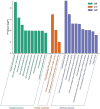Insights into the potential dual-antibacterial mechanism of Kelisha capsule on Escherichia coli
- PMID: 38807130
- PMCID: PMC11134901
- DOI: 10.1186/s12906-024-04500-7
Insights into the potential dual-antibacterial mechanism of Kelisha capsule on Escherichia coli
Abstract
Traditional Chinese medicine (TCM), AYURVEDA and Indian medicine are essential in disease prevention and treatment. Kelisha capsule (KLSC), a TCM formula listed in the Chinese Pharmacopoeia, has been clinically proven to possess potent antibacterial properties. However, the precise antimicrobial mechanism of KLSC remained unknown. This study aimed to elucidate the dual antibacterial mechanism of KLSC using network pharmacology, molecular docking, and experimental validation. By analyzing the growth curve of Escherichia coli (E. coli), it was observed that KLSC significantly inhibited its growth, showcasing a remarkable antibacterial effect. Furthermore, SEM and TEM analysis revealed that KLSC damaged the cell wall and membrane of E. coli, resulting in cytoplasmic leakage, bacterial death, and the exertion of antibacterial effects. The network pharmacology analysis revealed that KLSC exhibited an effect on E. coli ATP synthase, thereby influencing the energy metabolism process. The molecular docking outcomes provided evidence that the active compounds of KLSC could effectively bind to the ATP synthase subunit. Subsequently, experimental findings substantiated that KLSC effectively suppressed the activity of ATP synthase in E. coli and consequently decreased the ATP content. This study highlighted the dual antibacterial mechanism of KLSC, emphasizing its effects on cell structure and energy metabolism, suggesting its potential as a natural antibacterial agent for E. coli-related infections. These findings offered new insights into exploring the antibacterial mechanisms of TCM by focusing on the energy metabolism process.
Keywords: Kelisha capsule; ATP synthase; Antibacterial mechanism; Molecular docking; Natural medicine; Network pharmacology.
© 2024. The Author(s).
Conflict of interest statement
The authors declare no conflict of interest.
Figures










References
MeSH terms
Substances
Grants and funding
LinkOut - more resources
Full Text Sources
Medical

